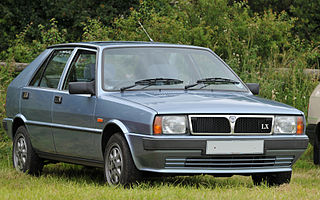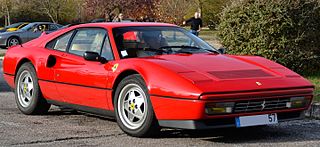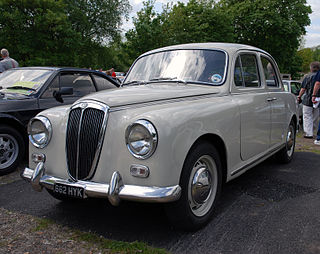
The Lancia Delta is a small family car produced by Italian automobile manufacturer Lancia in three generations. The first generation (1979-1994) debuted at the 1979 Frankfurt Motor Show, the second generation (1993-1999) debuted at the 1993 Geneva Motor Show, and the third generation (2008-2014) debuted at 2008 Geneva Motor Show.

The Ferrari 328 GTB and GTS are mid-engine V8, two seat sports cars created by Italian automobile manufacturer Ferrari. It was the successor to the Ferrari 308 GTB and GTS. While mechanically still based on the 308, modifications were made to the body, chassis, and engine, most notably an increase in engine displacement to 3.2 L for increased power and torque output. The 328 is still considered by some enthusiasts to be one of the most reliable and functional Ferraris; unlike other models, much of its maintenance can be performed without lowering the engine from the vehicle. In 1989, the 328 was succeeded by the 348.

The Ferrari F50 is a mid-engine sports car manufactured by Italian automobile manufacturer Ferrari from 1995 to 1997. Introduced in 1995, the car is a two-door, two seat targa top. The car is powered by a 4.7 L naturally aspirated Tipo F130B 60-valve V12 engine that was developed from the 3.5 L V12 used in the 1990 Ferrari 641 Formula One car. The car's design is an evolution of the 1989 Ferrari Mythos concept car.

The Fiat Tempra is a small family car produced by the Italian automaker Fiat from 1990 to 1997 in Italy. The Tempra was intended as a replacement for the Fiat Regata. The original project was called Tipo 3, being a mid size car between the Fiat Tipo and the bigger Fiat Croma. The Tempra shares its Type Three platform with the Lancia Dedra and Alfa Romeo 155.

The Lancia Thema is an executive car produced by the Italian automaker Lancia between 1984 and 1994, and one of four cars to share the Type Four platform alongside the Alfa Romeo 164, Fiat Croma and Saab 9000. The Thema was first shown in Turin Motor Show in 1984.

The Lancia Fulvia is an automobile produced by Lancia between 1963 and 1976. Named after Via Fulvia, the Roman road leading from Tortona to Turin, it was introduced at the Geneva Motor Show in 1963 and manufactured in three variants: Berlina 4-door saloon, 2-door Coupé, and Sport, an alternative fastback coupé designed and built by Zagato on the Coupé floorpan.

The Lancia Rally was a mid-engine sports car and rally car built by Lancia in the early 1980s to compete in the FIA Group B World Rally Championship. Driven by Markku Alén, Attilio Bettega, and Walter Röhrl, the car won Lancia the manufacturers' world championship in the 1983 season. It was the last rear-wheel drive car to win the WRC.

The Lancia Kappa or Lancia K is a front-engine, front-drive, four-door, five passenger, left-hand drive executive sedan manufactured and marketed by Italian automaker Lancia from 1994–2000, with estate and coupé variants — sharing platforms with the Alfa Romeo 166.

The Lancia Appia was a passenger car introduced in 1953 by Italian car manufacturer Lancia as a replacement for the Ardea, and which remained in production for ten years. The Appia was the last in a long line of Lancia production cars dating back to the Lancia Lambda to use the famous sliding pillar front suspension. All three series produced had a Lancia V4 engine of 1089 cc.

The ALFA 40/60 HP is a road car and race car made by Italian car manufacturer ALFA. This model was made between 1913 and 1922 and was designed by Giuseppe Merosi, as were all other Alfas at that time. The 40/60 HP has a 6082 cc straight-four engine with overhead valves, which produced 70 PS (51 kW) and its top speed was 125 km/h (78 mph). The 40-60 HP Corsa racing version had 73 PS (54 kW) and a top speed of 137 km/h (85 mph), and it also won its own category in the Parma-Berceto race.

The Lancia Artena is a passenger car produced by Italian car manufacturer Lancia from 1931 to 1936, and from 1940 to 1942 chiefly for army and government use. It was powered by a 2-litre Lancia V4 engine, while chassis and factory bodies were shared with the more luxurious 2.6-litre V8-engined Lancia Astura. Total production amounted to 5,567 examples.

The Lancia 20/30 HP, later known as Lancia Epsilon, is a passenger car produced by Italian car manufacturer Lancia between 1911 and 1912. The car was quite similar to the previous 20/30 HP Delta model. In total 357 were made.

The Lancia Kappa is a passenger car produced by Lancia between 1919 and 1922. Lancia's first post-war model, it was an updated version of the earlier Theta. 1,810 were made in total, surpassing the Theta as the best-selling Lancia motor car at the time.

The Lancia Trikappa is an automobile produced by Lancia between 1922 and 1925. It was a luxury car, the flagship of Lancia's production. The Trikappa 4.5-litre V8 is notable as the first of Lancia's narrow V engines, a distinguishing feature the manufacturer only abandoned in the 1970s. The car was offered as a bare rolling chassis, as torpedo or 6-seater coupé de ville. In total 847 were manufactured.

The Lancia 20 HP, later renamed Lancia Gamma, is a passenger car produced by the Italian car manufacturer Lancia during 1910. It was derived from a previous Beta model, now equipped with a bigger engine. In total, 258 units were built. In 1911, the type was superseded by the larger-engined and more powerful Lancia 20-30 HP Delta.
The Lancia 20-30 HP, later renamed Lancia Delta, is a passenger car produced by Italian car manufacturer Lancia during 1911. The Delta was based on the earlier 20 HP Gamma, with an enlarged engine. 303 Deltas were made in total, before it was replaced by the improved 20-30 HP Epsilon.
The Lancia Ro, Lancia Ro-Ro and Lancia 3Ro were 4x2 heavy trucks built by Italian manufacturer Lancia from the 1930s through the 1940s for military and civilian use. The 2-cylinder diesel Ro was produced from 1933 to 1939, the 3-cylinder diesel Ro-Ro from 1935 to 1939 and the improved 5-cylinder diesel 3Ro from 1938 to 1947.

The Lancia Jota is a series of truck and bus chassis produced by Lancia between 1915 and 1935. The original 1915 Jota was the first true Lancia truck; throughout the following two decades it was made in a number of different series and variants, each identified by a progressive Greek numeral prefix added to the name, from Djota to the last Eptajota. While axle tracks, wheelbase and equipment gradually grew, the original layout and 4,940 cc four-cylinder petrol engine were retained.
The Lancia 12 HP, later known as Lancia Zeta, is a passenger car produced by Lancia between 1912 and 1914. It was intended to be Lancia's smaller offering, positioned below the 4-litre 20/30HP Delta and Epsilon models. The Zeta did not prove a success, and production is estimated at just 34 examples ; none have survived.
The Lancia 1Z was a light military truck produced by Italian manufacturer Lancia between 1912 and 1916. From a mechanical standpoint, it was closely related to the 1913 35 HP Theta passenger car. It was Lancia's first military vehicle.
















